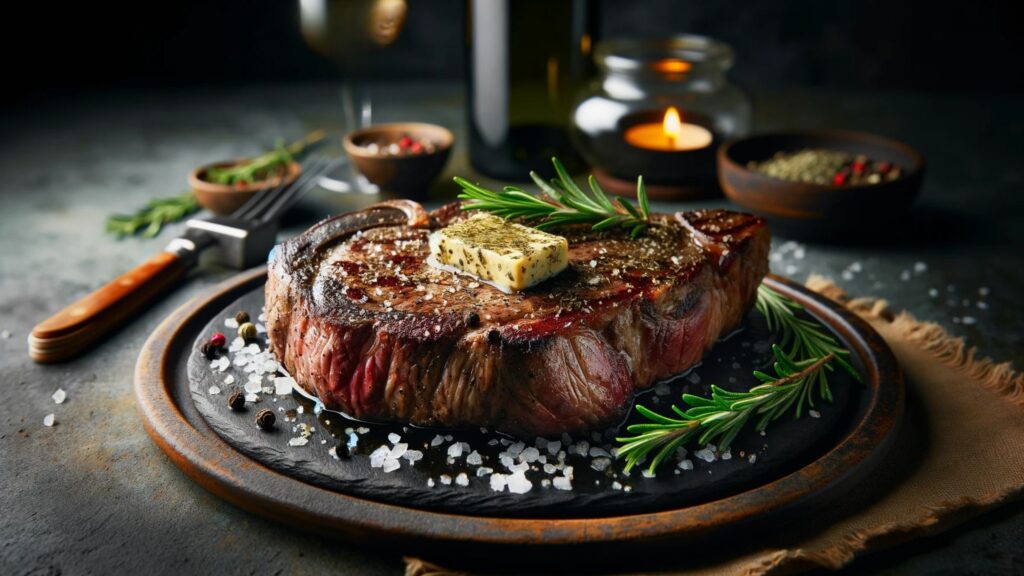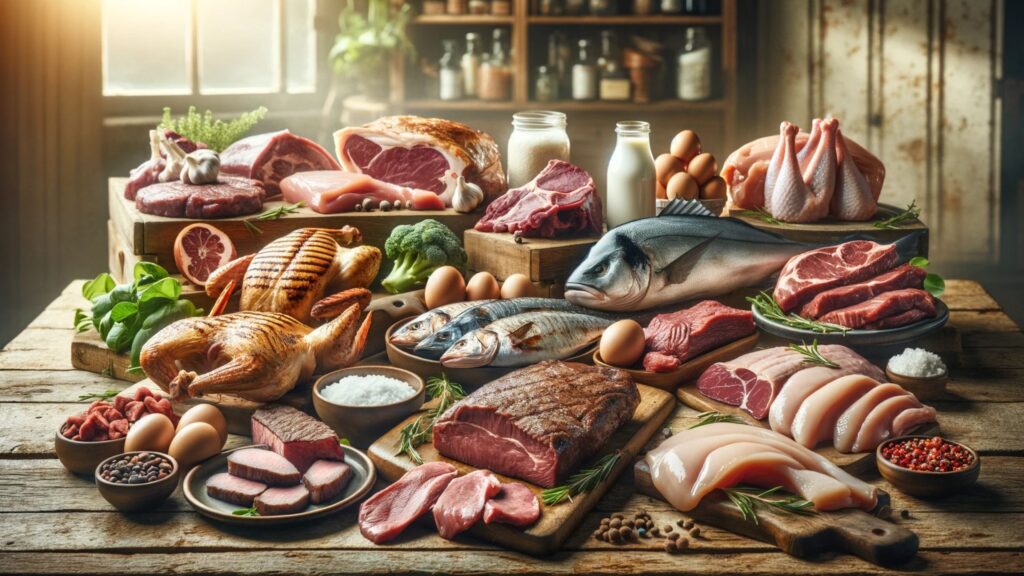Introduction
In recent years, the carnivore diet has surged in popularity, piquing the interest of health enthusiasts and diet explorers alike. This meat-centric approach to eating, often hailed for its simplicity and potential health benefits, is more than just a trend; it’s a lifestyle choice gaining serious traction.
What is the Carnivore Diet?
At its core, the carnivore diet is as straightforward as it sounds: a diet consisting almost entirely of animal products. Meat, fish, eggs, and certain dairy products form the crux of this plan, steering clear of plant-based foods.
This shift to an all-meat menu might seem daunting at first, but many have embraced it for its purported benefits, including improved digestion, weight management, and even enhanced mental clarity.
Crafting Your Carnivore Diet Meal Plan

Creating a carnivore diet meal plan requires more than just a love for steak; it’s about understanding the nuances of nutrition and the importance of quality and variety in your meat selection.
Whether you’re a seasoned carnivore dieter or a curious newcomer, our guide will provide you with comprehensive insights into meal planning, ensuring that your meat-based diet is both nutritious and enjoyable.
What to Expect from This Guide
In this article, we delve deep into the carnivore diet, providing you with an educational and engaging roadmap to mastering your meal planning. From debunking common myths to offering delicious and diverse meal options, we ensure your journey through the world of carnivore dieting is both inspirational and insightful. Plus, you’ll find this guide not only easy to follow but also a delightful read.
What is the Carnivore Diet?
The Carnivore Diet, at its simplest, is an eating regimen that involves consuming exclusively animal-based products. This diet has emerged as a counterpoint to plant-heavy eating styles, focusing on meats as the primary source of nutrition.
Defining the Carnivore Diet
Unlike omnivorous diets that include both animal and plant foods or vegetarian and vegan diets that eliminate animal products, the carnivore diet is unique in its exclusive focus on animal-derived foods.
Practitioners of this diet consume a variety of meats, including beef, chicken, pork, and fish, along with other animal products like eggs and certain dairy items.
This diet excludes all forms of fruits, vegetables, grains, nuts, seeds, and legumes, positioning itself as a stark contrast to traditional dietary guidelines that often emphasize a plant-based variety.
Core Principles of the Carnivore Diet
The fundamental principle of the carnivore diet revolves around the belief that human bodies are better adapted to a meat-centric diet, harking back to the eating habits of our ancestors.
Proponents argue that this diet can lead to various health benefits, such as improved digestion, reduced inflammation, and better management of autoimmune conditions.
The emphasis is on consuming whole, unprocessed animal products, preferably from high-quality, grass-fed, or pasture-raised sources. Processed meats and high-carb dairy products are generally discouraged to maintain the diet’s low-carb, high-protein nature.
Typical Foods in the Carnivore Diet
When following a carnivore diet, meal plans are predominantly composed of red meats like steak and ground beef, which are rich in protein and essential nutrients.
Poultry, organ meats, and fatty fish are also staples, providing variety and different nutritional profiles. Eggs, a versatile ingredient, and certain dairy products like butter and hard cheeses are often included for extra fat and flavor.
The diet avoids plant-based foods, sweeteners, and additives, aiming for a natural, unprocessed approach to eating.
Benefits of the Carnivore Diet

The Carnivore Diet, with its exclusive focus on animal-based foods, has been associated with a variety of potential health benefits. These benefits, supported by both anecdotal evidence and emerging scientific research, paint an intriguing picture of how a meat-centric diet might positively impact health.
Enhanced Weight Management
One of the most cited benefits of the carnivore diet is its effectiveness in aiding weight loss and management. The diet’s high protein content can lead to increased satiety, reducing overall calorie intake.
Studies have shown that diets rich in protein can boost metabolism and reduce hunger hormones, which are key factors in weight management.
Improved Digestive Health
Another potential benefit is improved digestive health. Supporters of the carnivore diet often report a reduction in bloating and other digestive issues.
The absence of fiber, which is a non-digestible carbohydrate found in plant foods, is thought to contribute to this improvement. While fiber is traditionally considered beneficial for digestion, some people may find a zero-fiber diet helps alleviate their digestive discomfort.
Reduced Inflammation and Autoimmune Responses
There is also evidence to suggest that the carnivore diet may help in reducing inflammation and autoimmune responses. This is particularly relevant given the misconceptions about red meat and its association with inflammation.
For a more in-depth understanding of this topic, our article, “Red Meat and Inflammation: A Scientific Investigation,” offers a thorough exploration of the latest research findings. By examining the scientific nuances behind red meat’s impact on inflammation, readers can make more informed decisions about their dietary choices.
Enhanced Mental Clarity and Energy Levels
Anecdotal reports from those following the carnivore diet often include improved mental clarity and higher energy levels. While comprehensive scientific studies are needed to fully understand these effects, the diet’s emphasis on high-quality protein and fats, which are essential for brain health, could be contributing factors.
Expert Opinions and Scientific Considerations
While the carnivore diet has its proponents, it’s important to note that expert opinions and scientific studies on its long-term effects are still evolving.
Nutritionists and dietitians highlight the need for balanced nutrition and caution against the exclusion of entire food groups. Potential dieters are encouraged to consult healthcare professionals and consider individual health needs when evaluating the carnivore diet’s suitability for them.
Planning Your Carnivore Diet Meal Plan

Embarking on a carnivore diet journey requires thoughtful planning to ensure nutritional adequacy and to maintain interest in the diet. This section offers practical guidance on starting your carnivore diet meal plan, focusing on the selection of meats and the management of portion sizes to meet individual health goals and dietary needs.
Starting with the Basics
The first step in planning your carnivore diet meal plan is understanding the basics. This means familiarizing yourself with the types of meats that are most beneficial and how they fit into your daily eating routine.
Opt for a variety of meats to ensure a range of nutrients – including beef, pork, lamb, chicken, fish, and organ meats like liver, which are nutrient-dense options.
Quality Over Quantity
When selecting meats, prioritize quality. Grass-fed and pasture-raised meats are often recommended for their higher nutrient profiles, including better omega-3 to omega-6 fatty acid ratios.
While these options might be more expensive, their nutritional benefits can be significant. If budget is a concern, balancing higher-quality meats with more affordable options is a practical approach.
Portion Control and Listening to Your Body
Portion control is crucial in the carnivore diet, but it doesn’t necessarily mean eating less. Instead, it’s about understanding your body’s hunger and fullness cues.
Unlike diets high in carbohydrates, which can cause fluctuations in hunger, a diet high in protein and fat often leads to more stable energy levels and a more consistent sense of satiety. Start with moderate portions and adjust based on how you feel.
Balancing Fats and Proteins
A key aspect of meal planning on the carnivore diet is balancing fats and proteins. While it’s a high-protein diet, incorporating enough fats is essential for energy and overall health.
This can be achieved by choosing cuts of meat that have a good balance of fat and lean protein and by including high-fat dairy products if they align with your dietary preferences.
Meal Planning and Preparation
Finally, successful meal planning involves some level of preparation. Consider batch cooking or preparing meats in different ways – grilling, roasting, slow cooking – to add variety. Having a plan for your meals can help prevent dietary boredom and make it easier to stick to your carnivore diet in the long term.
One-Week Carnivore Diet Meal Plan

Embarking on a carnivore diet can be an exciting culinary adventure. To help you get started, here’s a detailed one-week meal plan that includes meal times, portion suggestions, and a variety of meats to keep your diet diverse and enjoyable.
Day 1
- Breakfast: Scrambled eggs with diced bacon (8 AM)
- Portion: 3 eggs, 4 slices of bacon
- Lunch: Grilled chicken breast with butter (1 PM)
- Portion: 1 large chicken breast
- Dinner: Ribeye steak (6 PM)
- Portion: 1 medium-sized steak (about 8 oz)
Day 2
- Breakfast: Omelet with cheese and ground beef (8 AM)
- Portion: 3 eggs, ½ cup ground beef, 1 oz cheese
- Lunch: Baked salmon with lemon butter (1 PM)
- Portion: 1 salmon fillet (about 6 oz)
- Dinner: Pork chops with a side of bone broth (6 PM)
- Portion: 2 pork chops, 1 cup bone broth
Day 3
- Breakfast: Beef liver cooked in butter (8 AM)
- Portion: 4 oz beef liver
- Lunch: Tuna salad made with mayo (1 PM)
- Portion: 1 can of tuna, 2 tbsp mayo
- Dinner: Lamb chops with ghee (6 PM)
- Portion: 2-3 lamb chops
Day 4
- Breakfast: Bacon and eggs (8 AM)
- Portion: 4 slices of bacon, 3 eggs
- Lunch: Ground turkey patties (1 PM)
- Portion: 2 medium patties
- Dinner: Roasted duck breast (6 PM)
- Portion: 1 duck breast
Day 5
- Breakfast: Sardines with hard-boiled eggs (8 AM)
- Portion: 1 can of sardines, 2 eggs
- Lunch: Hamburger patties (1 PM)
- Portion: 2 patties (about 6 oz total)
- Dinner: New York strip steak (6 PM)
- Portion: 1 medium-sized steak (about 8 oz)
Day 6
- Breakfast: Smoked salmon with cream cheese (8 AM)
- Portion: 4 oz smoked salmon, 1 oz cream cheese
- Lunch: Beef short ribs (1 PM)
- Portion: 2-3 short ribs
- Dinner: Roast chicken thighs with skin (6 PM)
- Portion: 2-3 thighs
Day 7
- Breakfast: Pork belly slices (8 AM)
- Portion: 3-4 slices
- Lunch: Grilled shrimp with butter (1 PM)
- Portion: 6-8 large shrimp
- Dinner: Bison steak with a side of beef liver pate (6 PM)
- Portion: 1 bison steak, 2 tbsp beef liver pate
Customizing Your Meal Plan

A key to successfully adhering to the carnivore diet is tailoring your meal plan to fit your specific health goals and preferences. Whether you’re aiming for weight loss, muscle gain, or just maintaining overall health, understanding how to adjust your carnivore diet can make all the difference.
For Weight Loss
If your goal is weight loss, focus on leaner cuts of meat and control your portion sizes. While the carnivore diet is naturally low in carbs, calories still matter. Opt for chicken, turkey, lean beef cuts, and fish.
These protein-rich foods will help you feel full longer while keeping your calorie intake in check. Consider incorporating intermittent fasting, which many find complements the carnivore diet well for weight loss.
For Muscle Gain
On the flip side, if muscle gain is your objective, your focus should shift to higher-calorie, protein-rich foods. Include fattier cuts of meat, like ribeye steaks or pork belly, which provide both the protein needed for muscle repair and growth and the calories necessary for energy.
Don’t shy away from adding extra servings if your activity level demands it. Eating meals more frequently throughout the day can also help in meeting your increased nutritional needs.
Balancing Fats and Proteins
Balancing fats and proteins is crucial, regardless of your goal. While protein is essential, fats are your main energy source on the carnivore diet.
Include a mix of saturated and unsaturated fats from various animal sources for a well-rounded approach. For instance, pairing a lean chicken breast with a side of butter or a fatty fish like salmon can provide a good balance.
Variety for Nutritional Balance
Variety is not just the spice of life; it’s also key to a nutritionally balanced carnivore diet. Rotate different types of meats and fish throughout your week to ensure you’re getting a range of nutrients.
Incorporating organ meats like liver or heart can provide essential vitamins and minerals that might be less abundant in muscle meats.
Listening to Your Body
Finally, the most important aspect of customizing your carnivore diet is listening to your body. Pay attention to how different foods make you feel.
If certain meats don’t agree with you or you find yourself feeling sluggish, adjust accordingly. Everyone’s body reacts differently, and what works for one person might not work for another.
Cooking Tips and Best Practices

Adapting to a carnivore diet involves more than just choosing the right meats; it’s also about mastering the art of cooking them. Here, we share essential cooking tips and techniques specifically tailored to the carnivore diet, helping you make the most of your meat-based meals.
Choosing the Right Cooking Methods
The cooking method you choose can greatly impact the flavor and texture of your meats. For steaks and chops, grilling or pan-searing can create a delightful crust while keeping the inside tender.
Slow cooking is perfect for tougher cuts like brisket or ribs, as it tenderizes the meat over several hours. Baking or roasting is ideal for poultry and fish, providing an even cook with minimal effort.
Investing in Quality Cookware
Having the right tools can make a significant difference in the outcome of your meals. Invest in a good quality cast iron skillet – it’s versatile, lasts a lifetime, and is ideal for cooking almost any type of meat.
A meat thermometer is another crucial tool, ensuring your meats are cooked to the perfect temperature for safety and quality.
Seasoning Your Meats
While the carnivore diet limits the use of traditional seasonings like herbs and spices, you can still achieve flavorful results. Salt is your best friend here; it enhances the natural flavors of the meat.
For variety, experiment with different types of salt, like Himalayan pink salt or smoked salt. Also, consider using animal fats like butter or ghee for added richness.

Perfecting Steak Cooking
Steak is a staple in the carnivore diet, and perfecting its cooking is an art. Let the steak reach room temperature before cooking, and season generously with salt.
Sear it on high heat for a crisp exterior, then finish cooking at a lower temperature to your desired doneness. Resting the steak for a few minutes after cooking allows the juices to redistribute, ensuring a juicy, flavorful bite.
Utilizing Leftovers
Don’t let leftovers go to waste. Leftover meats can be repurposed into new meals – think steak slices over a bed of eggs for breakfast or shredded chicken mixed into a homemade pate. Being creative with leftovers not only saves time but also adds variety to your diet.
Safe Food Handling
Lastly, practicing safe food handling is paramount. Store meats properly in the refrigerator or freezer, and always cook meats to the recommended internal temperatures to prevent foodborne illnesses. Keeping your cooking space clean and sanitized is equally important, especially when handling raw meats.
Addressing Common Challenges and FAQs

Transitioning to a carnivore diet can come with its share of questions and challenges. In this section, we address some of the most common concerns, providing practical solutions and advice to help you navigate the diet successfully.
How Do I Deal with Limited Food Variety?
One common challenge is the perceived lack of variety in the carnivore diet. To combat this, focus on diversifying your meat selection. Experiment with different cuts of meat and types of fish, and incorporate organ meats for variety. Trying various cooking methods – grilling, roasting, slow cooking – can also introduce new flavors and textures, keeping meals interesting.
Can I Maintain This Diet with a Busy Lifestyle?
Maintaining a carnivore diet with a busy lifestyle is definitely doable with some planning. Meal prepping is key – cook in bulk and portion out meals for the week. Quick and easy options like canned fish, hard-boiled eggs, or pre-cooked meats can be lifesavers when you’re short on time.
Will I Get Enough Nutrients?
A concern often raised is whether the carnivore diet provides all necessary nutrients. While the diet is rich in protein and essential fats, ensure you’re getting a range of nutrients by including a variety of meats, especially organ meats, which are nutrient-dense. If concerned, consulting with a healthcare provider or a nutritionist can provide personalized advice.
Social situations and dining out can be challenging on a restrictive diet. When eating out, opt for simple dishes like steak or grilled fish. In social settings, explaining your dietary choices to friends and family can help in accommodating your needs. Bringing your own food to gatherings is also a viable option.
Dealing with Initial Side Effects
Some people experience initial side effects like fatigue or digestive changes when starting the diet. These are often temporary as your body adjusts. Staying hydrated and ensuring you’re eating enough, especially fats, can help mitigate these effects. If symptoms persist, consider consulting a healthcare professional.
Is the Carnivore Diet Sustainable Long-Term?
The sustainability of the carnivore diet long-term is a topic of debate. It’s important to monitor your health regularly through check-ups and listen to your body. Some may find a more balanced approach by occasionally including non-meat items, while others thrive on a strict carnivore regimen. Individual experiences vary, so finding what works best for you is key.

Conclusion
As we wrap up this comprehensive guide on the carnivore diet meal plan, it’s important to reflect on the key points we’ve covered. This diet, centered around animal-based foods, offers a unique approach to nutrition that many find beneficial for various health goals, including weight management, improved digestion, and enhanced mental clarity.
Revisiting the Benefits
We’ve explored the potential benefits of the carnivore diet, such as its simplicity and focus on high-quality proteins and fats. By choosing the right meats, balancing fat and protein intake, and incorporating variety through different cooking methods and cuts of meat, you can enjoy a diet that is not only nutritious but also satisfying.
Starting Your Carnivore Journey
Embarking on the carnivore diet journey can be an exciting and transformative experience. With the tips and guidelines provided in this article, you’re well-equipped to start planning and enjoying your meals. Remember, the key to success with this diet, as with any, is listening to your body and making adjustments to suit your individual needs and goals.
Seeking Further Resources
For those interested in exploring additional dietary approaches that focus on optimal human nutrition, our “Proper Human Diet: A Beginner’s Guide” offers valuable insights.
This guide delves into different aspects of nutrition and dieting that complement the principles of the carnivore diet. Whether you’re looking to expand your dietary knowledge or explore other nutrition strategies, this resource can serve as an excellent starting point.
Your Experience Matters
We’d love to hear about your experiences with the carnivore diet. Whether you’re just starting out or have been following this lifestyle for a while, your insights and questions are valuable. Feel free to share your journey in the comments below.
Spread the Word
If you found this guide helpful, consider sharing it with others who might be interested in the carnivore diet. Spreading awareness and knowledge helps build a supportive community where everyone can learn and grow in their health journeys.


